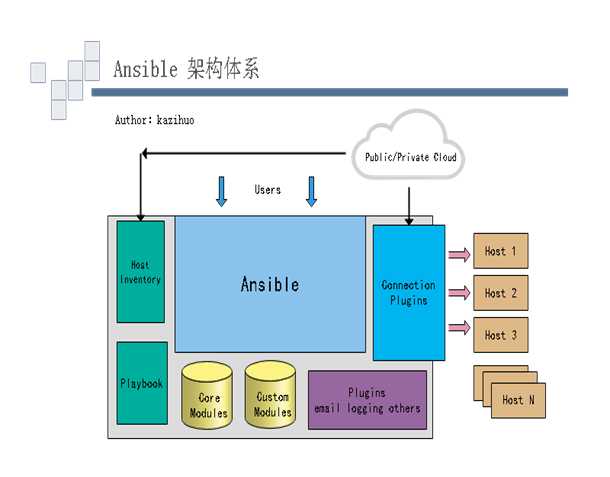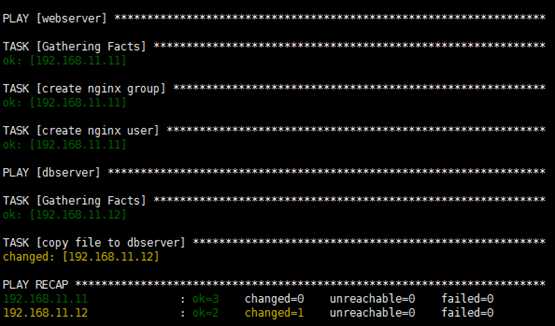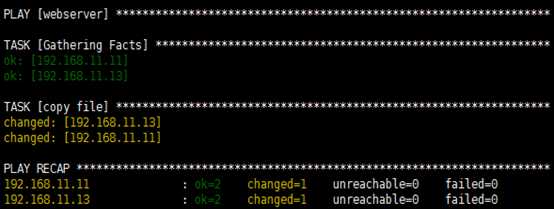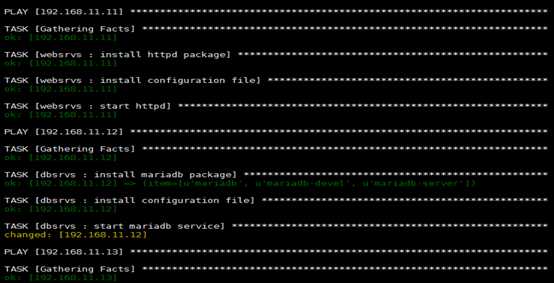标签:运维工具 模式 start gen 格式 运行命令 pat 角色 items
ansible基于python开发,集合众多运维工具(puppet ,cfengine ,chef ,func ,fabric)的优点,实现了批量系统配置、批量程序部署、批量运行命令等功能。其基于模块工作,本身没有批量部署能力,真正具有批量部署的是ansible所运行的模块,ansible只是提供一种框架。包括:
1)connection plugins:负责和被监控端实现通信;
2)host inventory:指定操作主机,是一个配置文件里面定义监控的主机;
3)modules:核心模块、command模块、自定义模块;
4)plugins:借助插件完成记录日志邮件等功能;
5)playbook:可实现一次性运行多个任务。

1)no agents:被管控主机上不需安装任何客户端;
2)no server:无服务器端,使用时直接运行命令即可;
3)modules in any languages:基于模块工作,可使用任意语言开发模块;
4)yaml:使用yml定制剧本playbook;
5)ssh by default:基于SSH工作;
6)strong multi-tier solution:可实现多机指挥。
1)轻量级,客户端不需agent;
2)批量执行任务可写成脚本,不用分发到远程就可执行;
3)使用python编写,维护更简单;
4)支持sudo。
依赖于epel源,可通过阿里云镜像站配置,使用前基于ssh无密认证。
# yum -y install ansible
配置文件:/etc/ansible/ansible.cfg
Invertory:/etc/ansible/hosts
# cat /etc/ansible/hosts
[webserver]
192.168.11.11
[dbserver]
192.168.11.12
Inventory
Modules
AD Hoc Commands
Playbooks
Tasks:任务
Variables:变量
Templates:模板
Handlers:处理器,由某事件触发执行的操作
Roles:角色
# man ansible
SEE ALSO
ansible-playbook(1), ansible-pull(1), ansible-doc(1), ansible-vault(1), ansible-galaxy(1)
# man ansible-doc
# ansible-doc -l
# ansible-doc -s MODULE_NAME
# man ansible-play
常见模块
command
#命令模块,默认模块(不写时默认有),用于远程执行命令;
# ansible all -a ‘date‘
cron
# ansible webserver -m cron -a ‘minute="*/10" job="/bin/echo kazihuo" name="test cron job" state=present‘
# ansible webserver -a ‘crontab -l‘
group
#ansible webserver -m group -a ‘name=mysql gid=306 system=yes‘
user
#ansible webserver -m user -a ‘name=mysql uid=306 system=yes group=mysql‘
copy
# ansible all -m copy -a ‘src=/etc/fstab dest=/tmp/fstab.ansible owner=root mode=640‘
# ansible all -m copy -a ‘content="Hello Ansible\nHi\n" dest=/tmp/kazihuo.ansible‘
template
file
# ansible all -m file -a ‘owner=mysql group=mysql mode=777 path=/tmp/kazihuo.ansible‘
#link
# ansible all -m file -a ‘path=/tmp/fstab.link src=/tmp/fstab.ansible state=link‘
ping
# ansible all -m ping
service
# ansible all -a ‘systemctl status httpd.service‘
# ansible all -m service -a ‘enabled=true name=httpd state=started‘
shell
# ansible all -m user -a ‘name=u1 password=000‘
# ansible all -m shell -a ‘echo 000000|passwd --stdin u1‘
script
#将本地脚本复制到远程主机并运行
# cat /tmp/test.sh
#!/bin/bash
echo "ansible from script" > /tmp/script.ansible
# ansible all -m script -a ‘/tmp/test.sh‘
# ansible all -m command -a ‘cat /tmp/script.ansible‘
yum
# ansible all -m yum -a ‘name=zsh state=present‘
# ansible dbserver -m yum -a ‘name=httpd state=absent‘
setup
#收集远程主机的facts(每个被管理节点在接收并运行管理命令之前,会将自己主机相关信息,如操作系统版本、IP地址等报告给远程的ansible主机)
# ansible all -m setup
介绍
YAML是一个可读性高的用来表达资料序列的格式。其参考了多种语言,包括:XML、C语言、Perl以及电子邮件格式RFC2822等。
特性
可读性好;
和脚本语言的交互性好;
有一个一致的信息模型;
易于实现;
可基于流来处理;
表达能力强,扩展性好;
语法
YAML语法和其他高阶语言类似,且可简单表达清单、散列表、标量等数据结构,其结构(Structure)通过空格来展示,序列(Sequence)里的项用“-”来表示,Map里的键值对用“:”分隔。
用于将批量操作主机分组命名,默认的inventory file是/etc/ansible/hosts;其可以有多个,也可通过Dynamic Inventory动态生成。
inventory文件遵循INI文件风格,中括号中字符为组名,同一个主机可同时归并到多个不同的组中;
当目标主机使用了非默认SSH端口,可在主机名称后使用冒号+端口号来标明。
eg:
[webserver]
192.168.10.11
192.168.10.12:222
当主机名遵循一定的命名模式,可用列表方式标识各个主机;
eg:
[webserver]
www[01:30].kazihuo.command
[dbserver]
db[a:e].kazihuo.com
主机变量
在inventory中定义主机时为其添加主机变量以便于在playbook中使用。
eg:
[webservers]
192.168.10.11 http_port=80 maxRequestsPerChild=808
组变量
指赋予给指定组内所有主机上的在playbook中的可用变量。
eg:
[webservers]
192.168.10.11
[webservers:vars]
ntp_server=ntp.kazihuo.com
组嵌套
inventoy中,组可以包含其他的组,也可向组中的主机指定变量,这些变量只能在ansible-playbook中使用,而ansible不支持。
eg:
[apache]
192.168.10.11
[nginx]
192.168.10.12
[webservers:children]
apache
nginx
[webservers:vars]
ntp_server=ntp.kazihuo.com
inventory参数
基于ssh连接inventory中指定的远程主机时,可通过参数指定其交互方式;
ansible_ssh_host
ansible_ssh_port
ansible_ssh_user
ansible_ssh_pass
ansible_sudo_pass
ansible_connection
ansible_ssh_private_key_file
ansible_shell_type
ansible_python_interpreter
ansible\_\*\_interpreter
playbook是由一个或多个“play”组成的列表。play的主要功能是将事先归并为一组的主机装扮成事先通过ansible中的task定义好的角色。从根本上来讲,所谓task无非是调用ansible的一个module。将多个play组织在一个playbook中,即可以让它们联同起来按事先编排的机制同唱一台大戏。
指定创建用户与组、传输文件;
# cat nginx.yml

1 - hosts: webserver 2 3 remote_user: root 4 5 tasks: 6 7 - name: create nginx group 8 9 group: name=nginx system=yes gid=208 10 11 - name: create nginx user 12 13 user: name=nginx uid=208 group=nginx system=yes 14 15 16 17 - hosts: dbserver 18 19 remote_user: root 20 21 tasks: 22 23 - name: copy file to dbserver 24 25 copy: src=/etc/passwd dest=/tmp/passwd.ansible
# ansible-playbook nginx.yml

指定主机通过yum部署httpd,设置开机自启,并指定配置文件,当配置文件发生改变后,再次执行,将重启httpd;
[root@k2 ~]# cat apache.yml

1 - hosts: webserver 2 3 remote_user: root 4 5 tasks: 6 7 - name: install httpd package 8 9 yum: name=httpd state=present 10 11 - name: install configuration file for httpd 12 13 copy: src=/root/conf/httpd.conf dest=/etc/httpd/conf/httpd.conf 14 15 notify: 16 17 - restart httpd 18 19 - name: start httpd service 20 21 service: enabled=true name=httpd state=started 22 23 handlers: 24 25 - name: restart httpd 26 27 service: name=httpd state=restarted
[root@k2 ~]# ansible-playbook apache.yml

基础变量应用;
[root@k2 ~]# cat /etc/ansible/hosts
1 [webserver] 2 3 192.168.11.11 testvar="q1" 4 5 192.168.11.13 testvar="q3" 6 7 [dbserver] 8 9 192.168.11.12
[root@k2 ~]# cat test.yml

1 - hosts: webserver 2 3 remote_user: root 4 5 tasks: 6 7 - name: copy file 8 9 copy: content="{{ ansible_all_ipv4_addresses }},{{ testvar }}\n" dest=/tmp/vars.ans
[root@k2 ~]# ansible-playbook test.yml

[root@Q1 /tmp]# cat vars.ans
[u‘192.168.11.11‘, u‘192.168.10.11‘],q1
[root@Q3 /tmp]# cat vars.ans
[u‘192.168.11.13‘],q3
通过变量实现对不同主机提供不同的配置文件;
[root@k2 ~]# cat /etc/ansible/hosts

1 [webserver] 2 3 192.168.11.11 http_port=80 4 5 192.168.11.13 http_port=90 6 7 [root@k2 ~]# cat template/httpd.conf.jinja2 |grep Listen 8 9 Listen {{ http_port }}
[root@k2 ~]# cat apache.yml

1 - hosts: webserver 2 3 remote_user: root 4 5 vars: 6 7 - package: httpd 8 9 - service: httpd 10 11 tasks: 12 13 - name: install httpd package 14 15 yum: name={{ package }} state=present 16 17 - name: install configuration file for httpd 18 19 template: src=/root/template/httpd.conf.jinja2 dest=/etc/httpd/conf/httpd.conf 20 21 notify: 22 23 - restart httpd 24 25 - name: start httpd service 26 27 service: enabled=true name={{ service }} state=started 28 29 handlers: 30 31 - name: restart httpd 32 33 service: name=httpd state=restarted
[root@k2 ~]# ansible-playbook apache.yml
[root@Q1 ~]# netstat -atunpl |grep 80

[root@Q3 ~]# netstat -atunpl |grep 90

条件判断,当满足某条件的主机才执行操作;
[root@k2 ~]# cat cond.yml

1 - hosts: all 2 3 remote_user: root 4 5 vars: 6 7 - username: user10 8 9 tasks: 10 11 - name: create {{ username }} user 12 13 user: name={{ username }} 14 15 when: ansible_fqdn == "node1,kaizhuo.com"
迭代,当有重复性执行的任务时,可使用迭代机制;
- name: add several users
user: name={{ item }} state=present groups=wheel
with_items:
- testuser1
- testuser2
上面语句的功能等同于下面的语句:
- name: add user testuser1
user: name=testuser1 state=present groups=wheel
- name: add user testuser2
user: name=testuser2 state=present groups=wheel
事实上,with_items中可以使用元素还可为hashes,例如:
- name: add several users
user: name={{ item.name }} state=present groups={{ item.groups }}
with_items:
- { name: ‘testuser1‘, groups: ‘wheel‘ }
- { name: ‘testuser2‘, groups: ‘root‘ }
roles能够根据层次型结构自动装载vars、tasks、handlers等,通过分别将变量、文件、任务、模板及处理器放置与单独的目录中,并可便捷的include所有的一种机制。
roles目录下包含:
tasks目录:至少包含一个main.yml文件,定义角色的任务列表;此文件可使用include包含其他的位于此目录中的task文件;
files目录:存放由copy或script等模块调用的文件;
template目录:template模块自动在此目录中寻找jinja2模板文件;
handlers目录:此目录中因包含一个main.yml文件,定义各handlers;
vars目录:包含一个main.yml文件,用于定义此角色中用到的变量;
meta目录:包含一个main.yml文件,用于定义特殊设定及其依赖关系;
default目录:包含一个main.yml,为当前角色设定默认变量时使用此目录;
[root@k2 ~]# mkdir -pv ansible_playbooks/roles/{websrvs,dbsrvs}/{tasks,files,templates,meta,handlers,vars}
[root@k2 ~/ansible_playbooks]# tree

1 . 2 3 ├── roles 4 5 │ ├── dbsrvs 6 7 │ │ ├── files 8 9 │ │ │ └── my.cnf 10 11 │ │ ├── handlers 12 13 │ │ │ └── main.yml 14 15 │ │ ├── meta 16 17 │ │ ├── tasks 18 19 │ │ │ └── main.yml 20 21 │ │ ├── templates 22 23 │ │ └── vars 24 25 │ └── websrvs 26 27 │ ├── files 28 29 │ │ └── httpd.conf 30 31 │ ├── handlers 32 33 │ │ └── main.yml 34 35 │ ├── meta 36 37 │ ├── tasks 38 39 │ │ └── main.yml 40 41 │ ├── templates 42 43 │ └── vars 44 45 └── site.yml 46 47 15 directories, 8 files
[root@k2 ~/ansible_playbooks]# cat site.yml

1 - hosts: 192.168.11.11 2 3 remote_user: root 4 5 roles: 6 7 - websrvs 8 9 - hosts: 192.168.11.12 10 11 remote_user: root 12 13 roles: 14 15 - dbsrvs 16 17 - hosts: 192.168.11.13 18 19 remote_user: root 20 21 roles: 22 23 - websrvs 24 25 - dbsrvs
[root@k2 ~/ansible_playbooks]# cat roles/dbsrvs/handlers/main.yml

1 - name: restart mariadb 2 3 service: name=mariadb state=restarted 4 5 [root@k2 ~/ansible_playbooks]# cat roles/dbsrvs/tasks/main.yml 6 7 - name: install mariadb package 8 9 yum: name={{ item }} state=present 10 11 with_items: 12 13 - mariadb 14 15 - mariadb-devel 16 17 - mariadb-server 18 19 - name: install configuration file 20 21 copy: src=my.cnf dest=/etc/my.cnf 22 23 tags: 24 25 - myconf 26 27 notify: 28 29 - restart mariadb 30 31 - name: start mariadb service 32 33 service: name=mariadb enabled=true state=started 34 35 [root@k2 ~/ansible_playbooks]# cat roles/websrvs/handlers/main.yml 36 37 - name: restart httpd 38 39 service: name=httpd state=restarted 40 41 [root@k2 ~/ansible_playbooks]# cat roles/websrvs/tasks/main.yml 42 43 - name: install httpd package 44 45 yum: name=httpd 46 47 - name: install configuration file 48 49 copy: src=httpd.conf dest=/etc/httpd/conf/httpd.conf 50 51 tags: 52 53 - conf 54 55 notify: 56 57 - restart httpd 58 59 - name: start httpd 60 61 service: name=httpd state=started
[root@k2 ~/ansible_playbooks]# ansible-playbook site.yml


标签:运维工具 模式 start gen 格式 运行命令 pat 角色 items
原文地址:http://www.cnblogs.com/kazihuo/p/7875059.html